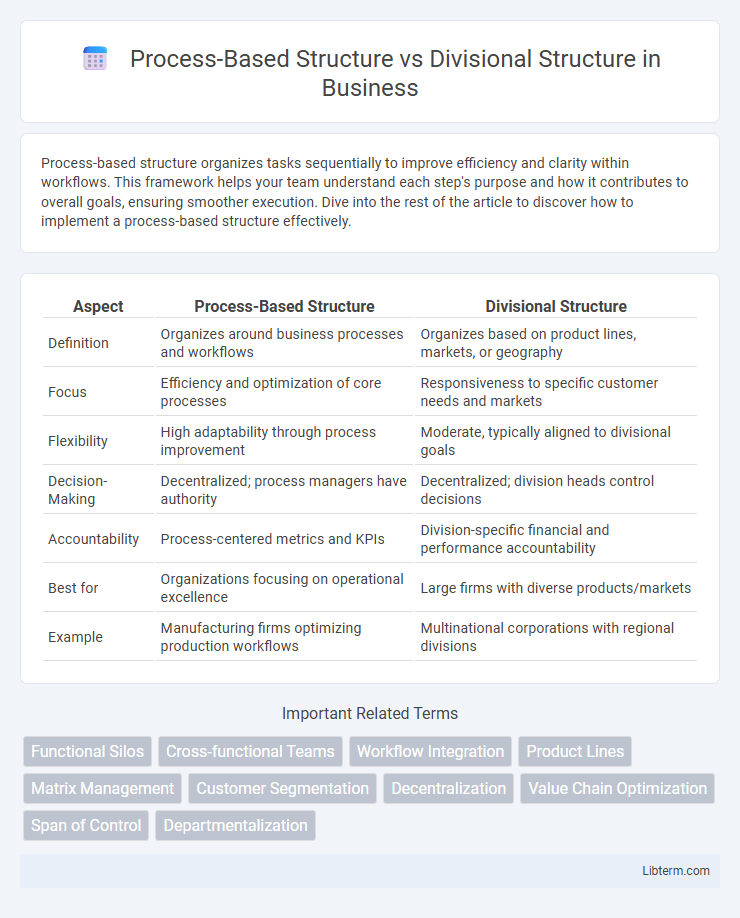Process-based structure organizes tasks sequentially to improve efficiency and clarity within workflows. This framework helps your team understand each step's purpose and how it contributes to overall goals, ensuring smoother execution. Dive into the rest of the article to discover how to implement a process-based structure effectively.
Table of Comparison
| Aspect | Process-Based Structure | Divisional Structure |
|---|---|---|
| Definition | Organizes around business processes and workflows | Organizes based on product lines, markets, or geography |
| Focus | Efficiency and optimization of core processes | Responsiveness to specific customer needs and markets |
| Flexibility | High adaptability through process improvement | Moderate, typically aligned to divisional goals |
| Decision-Making | Decentralized; process managers have authority | Decentralized; division heads control decisions |
| Accountability | Process-centered metrics and KPIs | Division-specific financial and performance accountability |
| Best for | Organizations focusing on operational excellence | Large firms with diverse products/markets |
| Example | Manufacturing firms optimizing production workflows | Multinational corporations with regional divisions |
Introduction to Organizational Structures
Process-based structures organize a company around core workflows and activities, promoting efficiency and cross-functional collaboration by aligning teams according to specific processes such as product development or customer service. Divisional structures segment the organization by product lines, markets, or geographic regions, enabling focused management and accountability for each division's performance and strategy. Understanding these foundational organizational structures helps companies choose frameworks that enhance coordination, flexibility, and strategic alignment.
Understanding Process-Based Structure
Process-Based Structure organizes a company around core business processes rather than traditional functions or product lines, enhancing workflow efficiency and cross-functional collaboration. This structure emphasizes end-to-end process improvement, enabling faster response to customer needs and better alignment with organizational goals. By focusing on processes such as order fulfillment, customer service, and product development, companies can reduce redundancies and optimize resource allocation.
Key Features of Divisional Structure
Divisional structure organizes a company into semi-autonomous units based on products, services, markets, or geographic locations, enhancing focus and accountability. Each division operates with its own functional teams like marketing, finance, and operations, promoting specialization and quicker decision-making within that division. This structure facilitates adaptability to market changes and improved customer responsiveness by decentralizing control and streamlining management at the division level.
Process-Based vs Divisional: Core Differences
Process-Based Structure organizes a company around workflows and activities to enhance efficiency and cross-functional collaboration, emphasizing end-to-end processes. Divisional Structure groups operations by product lines, markets, or geographic regions, enabling tailored strategies and accountability within each division. Key differences lie in Process-Based Structure's focus on horizontal processes versus Divisional Structure's vertical, market- or product-centric orientation.
Advantages of Process-Based Structure
Process-based structures enhance operational efficiency by organizing workflows around core business processes, resulting in streamlined communication and faster decision-making. This structure promotes cross-functional collaboration, breaking down departmental silos and fostering innovation through integrated teams focused on end-to-end processes. Companies adopting process-based structures often experience improved adaptability and customer responsiveness due to the clear alignment of activities with strategic objectives.
Benefits of Divisional Structure
The Divisional Structure enhances organizational flexibility by grouping teams based on products, markets, or geographic locations, allowing faster response to market changes. It improves focus and accountability as each division operates as a semi-autonomous unit with its own resources and objectives. This structure facilitates specialized expertise and better coordination within divisions, leading to improved customer satisfaction and competitive advantage.
Challenges of Process-Based Structure
Process-based structure poses challenges such as complex coordination across cross-functional teams, leading to potential communication breakdowns and slower decision-making. Employees may face difficulties adapting to multiple reporting lines, causing role ambiguity and reduced accountability. Maintaining consistency in process execution across diverse units demands significant management oversight and continuous process improvement efforts.
Drawbacks of Divisional Structure
The divisional structure often leads to resource duplication and increased operational costs due to autonomous departments functioning independently. It can create challenges in maintaining standardized procedures and hinder inter-divisional communication and collaboration. This fragmentation may result in conflicts of interest and difficulties in aligning overall company objectives.
Choosing the Right Structure for Your Business
Process-based structure enhances operational efficiency by organizing workflows around core business processes, ideal for companies prioritizing streamlined production and service delivery. Divisional structure groups activities by product lines, markets, or geographic locations, offering flexibility and focus for diversified organizations with distinct business units. Selecting the right structure depends on your business size, complexity, and strategic goals, where process-based suits standardization needs and divisional supports scalability and market responsiveness.
Conclusion: Process-Based or Divisional?
Choosing between a process-based structure and a divisional structure hinges on organizational goals and complexity. Process-based structures enhance efficiency by streamlining workflows across functions and promoting collaboration on end-to-end processes. Divisional structures offer flexibility and market responsiveness by grouping resources around products, customers, or regions, making them ideal for diversified companies operating in multiple markets.
Process-Based Structure Infographic

 libterm.com
libterm.com